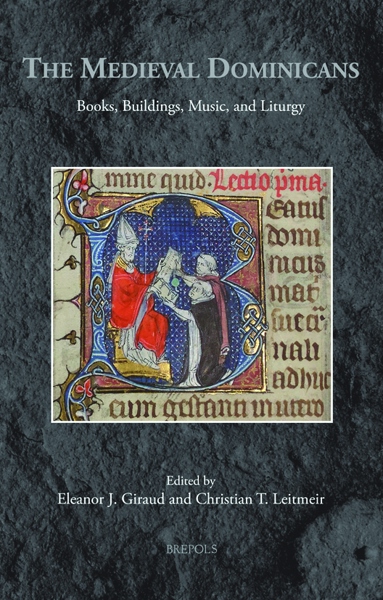
The Late Medieval Cistercian Monastery of Fountains Abbey, Yorkshire
Monastic Administration, Economy, and Archival Memory
Michael Spence
- Pages: 208 p.
- Size:156 x 234 mm
- Illustrations:17 b/w, 18 tables b/w.
- Language(s):English
- Publication Year:2020
- € 75,00 EXCL. VAT RETAIL PRICE
- ISBN: 978-2-503-56771-6
- Hardback
- Available
- € 75,00 EXCL. VAT RETAIL PRICE
- ISBN: 978-2-503-56772-3
- E-book
- Available
A systematic analysis of three contemporary manuscripts from Fountains Abbey - the wealthiest English Cistercian monastery - revealing key insights into monastic administration.
“Overall, this is a very impressive project. Few of us could produce such an all-encompassing account of how new economic (and political) priorities are reflected in a single monastic archives over time. (...) Spence has shown very clearly how much the monks' and abbots' approaches to those archives changed over the medieval centuries.” (Constance Hoffman Berman, in The Medieval Review, 05/05/2021)
“This is not a book for the faint hearted. It challenges the reader with a densely written, detailed, critical and searching account of documents, especially the cartularies, compiled by the monks of Fountains Abbey in the late middle ages.” (Christopher Dyer, Northern History, 58/1, 2020, p. 155)
"Für die Ordens-, Wirtschafts- und Archivgeschichte bietet die Veröffentlichung viel Neues und eine spannende methodische Herangehensweise. Als Band V der seit 2015 veröffentlichten Medieval Monastic Studies sind das innere und äußere Erscheinungsbild, die bibliografische Qualität und der Index hervorragend. Der Rezensent wünscht der Veröffentlichung große Aufmerksamkeit in der Forschungslandschaft." (Klaus Wollenberg, in Sehepunkte, 21/7-8, 2021)
“While few British abbeys boast a late medieval archive as comprehensive as that originating at Fountains, Spence’s methodology, framework, and conclusions point the way for the continued nuancing of current approaches to monastic cartularies.” (Kathryn Dutton, in the Journal of British Studies, 62/1, 2022, p. 268)
“(…) this volume provides a valuable analysis of the ways monks shaped their archives to respond to economic, legal, and political situations. Spence’s application of forensic methods to these documents offers an important model for the study of other monastic archives.” (Martha G. Newman, in Church History, June 2023, p. 448)
"Nunca hubiese imaginado que un estudio histórico referido a la economía y la administración de una institución pudiese ofrecer un análisis de los documentos archivísticos tan lúcido como el del libro aquí reseñado. Su original enfoque ofrece nuevas perspectivas esenciales para releer las fuentes primarias, hasta el punto de que considero que marca un hito historiográfico. A ello se suma una rigurosa metodología científica expresada mediante una amena redacción, de resultados brillantes" (Leonor Zozaya Montes, in Hispania Sacra, 76/153/1006, 2024)
Founded in 1132, Fountains Abbey became the wealthiest English Cistercian monastery — yet relatively little analysis has been made of its surviving records to investigate how its wealth was controlled and sustained. This book deals with this secular aspect of the religious community at Fountains, investigating in particular the way in which prosaic business records were compiled and redacted. It traces the transmission of data from original charters through successive versions of cartularies, and in the process establishes the existence of a previously unknown manuscript. It also reveals how abbots in the fifteenth century interacted with and adapted the records in their care.
In this process, two quite different aspects of monastic life are uncovered. First, it sheds new light on the history of Fountains Abbey through the fourteenth and fifteenth centuries, amongst other things how it responded to the turmoil of the Black Death, and discloses for the first time the allegiance of one abbot to the Lancastrian cause during the Wars of the Roses. Second, it reveals the worldly skills shown by the community of Fountains that were successfully applied to exploit the monastery’s large landholdings across Yorkshire, mainly through wool and agricultural production, but also through fisheries, tanning, mining, and metalworking. The economic success of these activities enabled the abbey to become a prosperous institution which rivalled the wealth of the aristocracy.
This book addresses recordkeeping and archival memory at one, Cistercian, monastery — albeit a well-endowed and prosperous one — in the north of England. However, its treatment of archival sources could be extended to other houses in different geographical locations and different orders, to enable comparisons between monasteries dealing with economic change and social and political upheaval in the later Middle Ages.
List of Illustrations
Acknowledgments
List of Abbreviations
Introduction
Chapter 1: Fountains Abbey: Origins and Development, Antiquarians, and Modern Scholarship
Chapter 2: Fountains Abbey in the Long Fifteenth Century
Chapter 3: Charters, Cartularies, and Archival Redaction
Chapter 4: Abbot Greenwell’s Aide-Memoire? The President Book of Fountains Abbey
Chapter 5: Creative Redaction: Reassembling the Past and Developing an Audit Trail
Chapter 6: Reflective Redaction: Reviewing the Past
Chapter 7: A Forensic Approach to Fountains Cartularies
Conclusion
Appendix A: The President Book of Fountains Abbey
Appendix B: Cartulary 2, WYAS 150/5384
Appendix C: Cartulary RP, Univ. Coll. MS 167
Appendix D: Rentals, Add MS 40010
Appendix E: Fountains Abbey Manuscripts
Appendix F: The Charter of William of Goldsborough
Bibliography
Index




